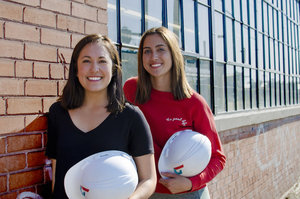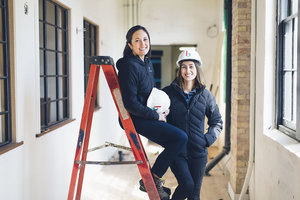
With the development of project management softwares, time-keeping applications, and bid-management programs, the way work gets done in the construction industry is rapidly changing. Changing so much, in fact, that people often refer to the creators of these technologies as “disruptors.” Two of those disruptors are Lauren Lake and Mallorie Brodie. The marriage of their two different, yet complementary, backgrounds allowed for Lake and Brodie to co-found Bridgit, a construction punch list solution. In this Women in Construction profile, Lake describes her and Brodie’s persistence and dedication to bringing new technology to the job site.
Can you explain what your role is at Bridgit?
Yep! So I’m one of the co-founders of Bridgit. The company was started by Mallorie and myself about four years ago. Since starting the company, we’ve kind of focused our efforts in different areas — Mallorie has been focusing on the financial side of the product, so like investments, operations, and finance, and then I’ve been focused on sales and customer experience.
So what was the path you took to get you to where you are today?
I had a very weird path, but Mallorie went to school for business. She always knew she wanted to go down the entrepreneurship road and really wanted to have her own company at some point, so she came from the business side. I came from the engineering side.
We both went to Tulane College — that’s how we met. I [was studying] civil engineering and working for a construction company, so with Mallorie and myself meeting and realizing we had these two different areas of expertise, that’s where the company got started.
Since you were the one who had been working in the construction industry and studied civil engineering, had you always wanted to do something in the AEC?
I kind of stumbled into engineering just cause of my interests in high school, but it wasn’t something growing up I would’ve said it was something I was going to do. I always loved math and science. I liked problem solving, so engineering was recommended to me by a couple teachers, and, at the time, I honestly didn’t know a lot of what engineering was really about. But I ended up going to engineering school, and from there ended up in the civil stream. And, I mean, I really enjoyed school, but I wouldn’t say it was my passion to stay in the civil engineering field, which is why I kind of found myself going more the business route.
Well, now that you are in the construction industry, what would you say has kind of been one of your favorite moments starting a company in the built environment?
I mean, there’s been a lot. I think the construction industry, for us, has been really exciting because it’s such a massive industry and there’s so many things going on constantly. It’s very complex, and I think we’ve been able to see a lot of places where we can really help on the technology side. Originally people thought the industry wasn’t going to adopt technology that quickly, and I think we’re kind of seeing the opposite. There’s so much rapid technology adoption in construction right now that it makes it such an exciting place to be. So I think for us it’s just been this mega-industry that has so much potential and being able to see how quickly things are changing has been really exciting.
“Originally people thought the industry wasn’t going to adopt technology that quickly, and I think we’re kind of seeing the opposite. ”
It sounds like you guys have had some positive experiences, but have there been any challenging moments?
There are always challenging moments. At the beginning, when we were first starting the company, we were getting tons and tons of feedback from people on site. When we started, we had this idea of being able to build technology for construction sites. And so our idea was kind of open-ended in the beginning. It was kind of like, “Okay, well we know there’s not a ton of technology available for construction sites, [so] let’s see if there’s a void that we can fill and build a company from that.” But we knew we needed to get more details; we needed to figure out exactly what we were going to build, blah, blah, blah.
So at that point, we said, “Ok, the only way to understand exactly what this company is going to be is if we go and ask people who are in the industry and live these challenges day in and day out.” So we spent the first 6 months doing what we called crane hunting. We would get in a car and literally look for cranes off the horizon and, when we’d find one, we’d drive in that direction until we ended up at the construction site.
So then we’d show up and start talking to people on the site and say, “Hey, we want to start this company to help you. What’s are the biggest challenges that you face on site? What’s the product we could build to make your job better?” We did that about 500 times in the first six months and gathered a ton of information.
As soon as people heard what we wanted to do and that we wanted to help, they got really excited. It was the first time they’d been asked for input on a new software product. [Then] it was really challenging to narrow down what we wanted to focus on because every day we would talk to ten more people, and they would come up with ten more awesome ideas.
I’d say that part was challenging in the beginning just because there was such an information overload. Since then our challenges have changed, but you kind of learn as you go. Every step we take in the company we kind of find our place a little bit more, and it kind of helps us figure out the next thing.
What were people’s reactions when you first starting going on sites? I mean, I know you said they were excited, but did you ever have people who were skeptical?
I’d say there were definitely some people at the very beginning who were like, “Uh, what are these two doing here?” But as soon as we spoke for 30 seconds, we clearly knew what we were talking about, I think the view changed from them being like, “Oh, this is a joke,” to, “Oh, they actually know what my job entails.”
What do you want to accomplish in the future?
When we first started, we were very adamant that we wanted to focus on one thing and do it really well. We saw a lot of companies try to focus on everything, and then they just got stuck with products that didn’t really do that much. So we’re still very focused on punch list management. We want to make the experience for both the subcontractor and general contractor as seamless as possible, and we still have a lot of work we think we can do there. Going past that, we want to continue building in the same space. Kind of the most natural place for us to go next is to build similar systems that still work with the on-site team and follow very similar communication paths. It would be a very natural expansion of the product, and it’d allow people to use the product not just for punch list but then for additional things.
“It’s really hard to picture yourself in an industry if you don’t see somebody whom you can imagine yourself being in it.”
What do you feel like could be done to get more women to join or be interested in the AEC industry?
I think the biggest thing for getting more women involved is just having more role models in the industry. I think the biggest thing is that if you’re like a 10-year-old girl, lets say, it’s really hard to picture yourself in an industry if you don’t see somebody whom you can imagine yourself being in it. So I think the more females we see in the industry, and even if that just means highlighting the women that we do have in the industry, I think that’ll give the 10-year-olds out there someone to look at and be like, “Oh, you know what, I could be [her] in 15 years.” So I feel like that’s the biggest thing is just seeing more of those role models.
Learn more about Bridgit and demo their punch list software here!




Discussion
Be the first to leave a comment.
You must be a member of the BuiltWorlds community to join the discussion.